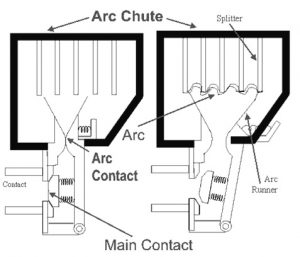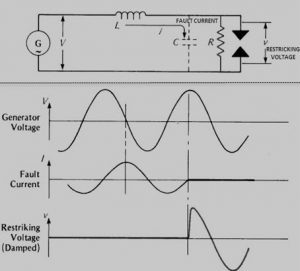Air Circuit Breaker (ACB) is an electrical device used to provide Overcurrent and short-circuit protection for electric circuits over 800 Amps to 10K Amps. These are usually used in low voltage applications below 450V. We can find these systems in Distribution Panels (below 450V). Here in this article, we will discuss the working of Air Circuit Breaker.
An air circuit breaker is a circuit operation breaker that operates in the air as an arc extinguishing medium, at a given atmospheric pressure. There are several types of air circuit breakers and switching gears available in the market today that are durable, high-performing, easy to install and maintain. The air circuit breakers have completely replaced oil circuit breakers.
The construction of an air circuit breaker can be done by using different internal and external parts like the following.
The external parts of ACB mainly include the ON & OFF button, an indicator for the position of the main contact, an indicator for the mechanism of energy storage, LED indicators, RST button, controller, rated nameplate, handle for energy storage, displays, shake, fault trip rest button, rocker repository, etc.

Air circuit breakers operate with their contacts in free air. Their method of arc quenching control is entirely different from that of oil circuit-breakers. They are always used for the low-voltage interruption and now tends to replace high-voltage oil breakers. The below-shown figure illustrates the principle of air breaker circuit operation.
Air Circuit breakers generally have two pairs of contacts. The main pair of contacts (1) carries the current at normal load and these contacts are made of copper metal. The second pair is the arcing contact (2) and is made of carbon. When the circuit breaker is being opened, the main contacts open first. When the main contacts opened the arcing contacts are still in touch with each other.
As the current gets a parallel low resistive path through the arcing contact. During the opening of the main contacts, there will not be any arcing in the main contact. The arcing is only initiated when finally the arcing contacts are separated. Each of the arc contacts is fitted with an arc runner which helps.
The arc discharge moves upward due to both thermal and electromagnetic effects as shown in the figure. As the arc is driven upward it enters the arc chute, consisting of splatters. The arc in the chute will become colder, lengthen, and split hence arc voltage becomes much larger than the system voltage at the time of operation of an air circuit breaker, and therefore the arc is extinguished finally during the current zero.
The air brake circuit box is made of insulating and fireproof material and it is divided into different sections by the barriers of the same material. At the bottom of each barrier is a small metal conducting element between one side of the barrier and the other. When the arc, driven upwards by the electromagnetic forces, enters the bottom of the chute, it is split into many sections by the barriers, but each metal piece ensures electrical continuity between the arcs in each section, the several arcs are consequently in the series.
The electromagnetic forces within each and every section of the chute cause the arc in that section to start the form of a helix, as shown above, figure (b). All these helices are in series so that the total length of the arc has been greatly extended, and its resistance is abundantly increased. This will affect the current reduction in the circuit.
Figure (a) shows the development of the arc from the time it leaves the main contacts until it is within the arc chute. When the current next ceases at a current zero, the ionized air in the path of where the arc had been being in parallel with the open contacts and acts as a shunt resistance across both the contacts and the self-capacitance C, shown in the below figure with red as a high resistance R.
When the oscillation starts between C and L as described for the idealized circuit breaker shown in Figure below, this resistance damps the oscillation heavily. Certainly, it is usually so heavy that the damping is critical, the oscillation cannot then take place at all, and the restriking voltage, instead of appearing as a high-frequency oscillation, rises dead-beat to its eventual value of peak generator voltage. This is shown below the lower waveform.

The air circuit breakers are mostly of four types and are widely used for maintaining the indoor medium voltage and switch gears of the home.
Plain brake air circuit breakers are the simplest form of air breakers. The main points of contacts are made in the shape of two horns. The arc of these circuit breakers extends from one tip to the other. This kind of circuit breaker is also known as cross blast ACB. The arrangement of this can be done through a chamber (arc chute) which is surrounded by the contact.
The chamber or arc chute helps in achieving cooling and it is made with refractory material. The arc chute contains walls inside and it is separated into small compartments using metallic separation plates. These plates are arc splitters where each compartment will work as a mini-arc chute.
The first arc will divide into a sequence of arcs so that all arc voltages will become higher as compared with the system voltage. These are used in low voltage applications.
Circuit Breaker Testing is mainly used to check each switching system operation as well as the programming of the complete tripping construction. So, testing is very essential for any kind of circuit breaker to ensure secure and consistent performance. As compared to other devices, performing testing is more challenging.
When a malfunction occurs in a circuit breaker then it can lead to a short circuit within the coils, incorrect behavior, damage the mechanical connections, etc. Thus, circuit breakers need to test regularly to overcome all these faults.
Different types of tests performed in circuit breaker mainly include mechanical, thermal, dielectric, short circuit, etc. The routine tests of a circuit breaker are a trip test, insulation resistance, connection, contact resistance, overload tripping, instantaneous magnetic tripping, etc.
For testing a circuit breaker, different kinds of test equipment are used to verify the condition of the circuit breaker in any power system. This testing can be performed through different test methods as well as kinds of testing equipment. The testing devices are analyzer, micro ohmmeter, primary injection tester with high current, etc. There are some benefits of circuit breaker testing like the following.
The advantages of an air circuit breaker include the following.
The disadvantages of air circuit breaker include the following.




